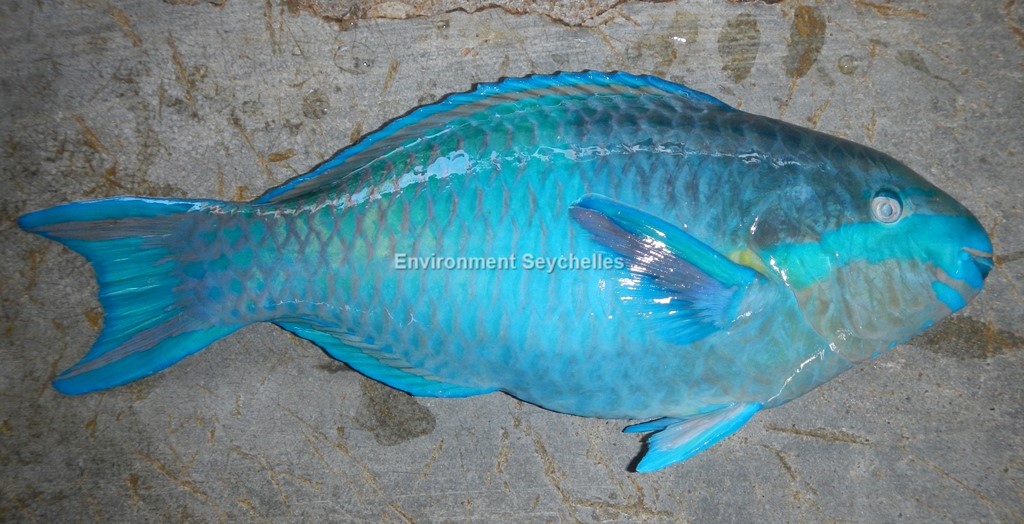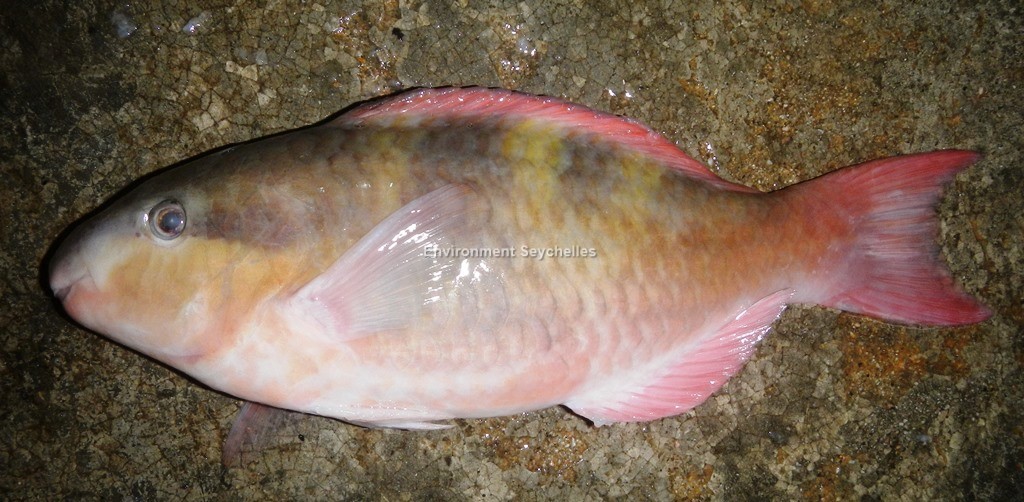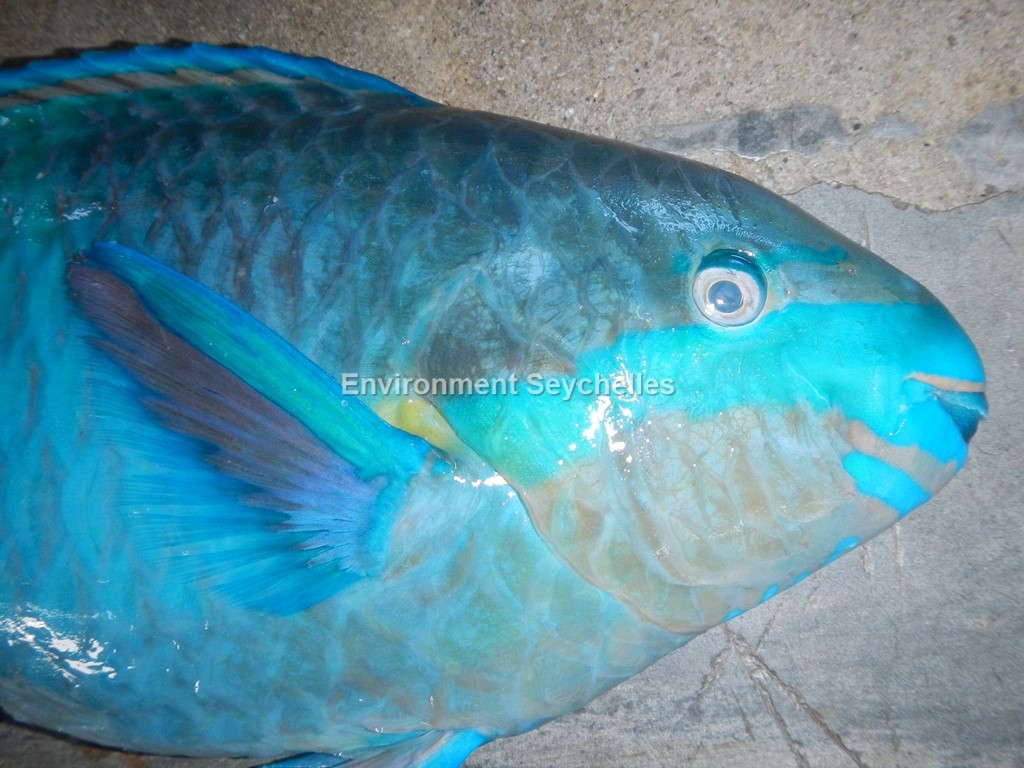Description:
Dorsal spines: 9; Dorsal rays: 10; Anal spines: 3; Anal rays: 9
Small to small-medium sized parrotfish. Dental plates, ¾ to fully covered by lips, off white in Initial phase and blue-green in Terminal phase. No canine
teeth. Caudal fin truncate or slightly emarginate in the Initial phase and lunate in Terminal phase.
Initial Phase: upper 1/3 of body with 4 alternating slightly diagonal bars of dark grey and yellow, lower 2/3 and ventral part of head whitish with a
pink cast or light yellowish, the edges of the scales dusky (except ventrally). Head from lower edge of orbit upwards dark grey, suffused with yellow.
Median and pelvic fins pale pink. Pectoral fins pale yellowish. In life may exhibit a dark stripe from side of snout through eye to upper end of operculum,
and a broad zone of yellow on cheek below dark stripe.
Terminal Phase: dorsal part of head and anterior upper half of body dark purplish grey; rest of body green, the edges of the scales pale pink. A broad
blue-green band from front of snout and lower lip across cheek to edge of operculum ending with a yellow patch immediately above pectoral fin base. Upper
lip edged in pale pink. Chin salmon pink with transverse blue-green band. Dorsal fin orange with green base and broad blue margin. Anal fin blue with pale
orange band basally. Pectoral fins with blue upper border, purple middle zone and the lower part blue. Pelvic fins pink with blue margin. Caudal fin blue
with a band of orange in each lobe.
Size:
Maturity: Lm unknown. Range unknown. Max Length: 37 cm TL (Terminal phase)
Habitat and Ecology:
Inhabits sheltered, reef associated environments such as lagoons and areas with dense coral cover (depth 1-25 m). Solitary or in small schools. Grazes
algae in coral reefs. Oviparous, distinct pairing during breeding.
Fishery Status:
This species is not protected or subject to fishery regulations. It is caught in the trap fishery, but is an uncommon to rare component of the catch.
Notes:
References:
Choat, J.H. et al. (2012). Scarus scaber. The IUCN Red List 2012: http://dx.doi.org/10.2305/IUCN.UK.2012.RLTS.T190700A17790871.en. (01/04/19).
Froese, R. & D. Pauly. (Eds.) (2019). FishBase. https://www.fishbase.de/summary/7913 (01/04/19).
Heemstra P & Heemstra, E. (2004). Coastal Fishes of Southern Africa. NISC SAIAB. ISBN: 1-920033-01-7.
Randall, J.E. & Bruce, R.W. (1983). The Parrotfishes of the Subfamily Scarinae of the Western Indian Ocean with Descriptions of Three New species.
Ichthyological Bulletin of the J.L.B. Smith Institute of Ichthyology. Number 47 March1983 ISSN: 0073-4381
Citation:
Nevill, J.E.G. (2019). Scarus scaber, Fivesaddle parrotfish. Seychelles Seatizens. www.seatizens.sc. https://seatizens.sc/species/scarus-scaber-valenciennes-1840/ (edited 22/08/22).




Great platform with useful analytics — it made my crypto journey easier. Charts are accurate and load instantly.
I personally find that this platform exceeded my expectations with accurate charts and easy onboarding. Definitely recommend to anyone in crypto.
I value the robust security and accurate charts. This site is reliable.
danatoto
I was skeptical, but after a week of learning crypto basics, the easy onboarding convinced me. Support solved my issue in minutes.
I personally find that i value the stable performance and responsive team. This site is reliable.
The user interface of paraswap defi is so clean and incredibly easy to navigate….
Very informative blog post.Really looking forward to read more. Awesome.
I’ve been using it for several months for checking analytics, and the seamless withdrawals stands out. The mobile app makes daily use simple.
I’ve been using it for since launch for using the mobile app, and the seamless withdrawals stands out.
I personally find that i’ve been active for several months, mostly for cross-chain transfers, and it’s always intuitive UI.
I switched from another service because of the easy onboarding and fast transactions. Charts are accurate and load instantly.
I switched from another service because of the stable performance and responsive team.
I personally find that i switched from another service because of the reliable uptime and easy onboarding. Charts are accurate and load instantly.
Lee here — I’ve tried staking and the clear transparency impressed me.
I personally find that i’ve been using it for since launch for swapping tokens, and the quick deposits stands out.
Wow, great blog article.Thanks Again. Fantastic.
I really like and appreciate your post.Really looking forward to read more. Awesome.
I really liked your blog.Thanks Again. Awesome.
I really liked your article post.Really looking forward to read more.
The using the API tools are quick deposits and wide token selection.
The cross-chain transfers tools are wide token selection and seamless withdrawals.
I value the blog post.Really looking forward to read more.
I switched from another service because of the wide token selection and low fees. Charts are accurate and load instantly.
I’ve been active for almost a year, mostly for exploring governance, and it’s always seamless withdrawals. Support solved my issue in minutes.
Thanks-a-mundo for the blog post.Much thanks again. Really Great.
Say, you got a nice blog.Really looking forward to read more. Awesome.
Looking forward to reading more. Great article.Much thanks again. Cool.
Major thankies for the blog. Really Cool.
Enjoyed every bit of your blog. Great.
I value the article post. Keep writing.
Thanks for sharing, this is a fantastic blog.Really looking forward to read more. Fantastic.
Great blog.Thanks Again. Awesome.
Im grateful for the article post.Thanks Again. Great.